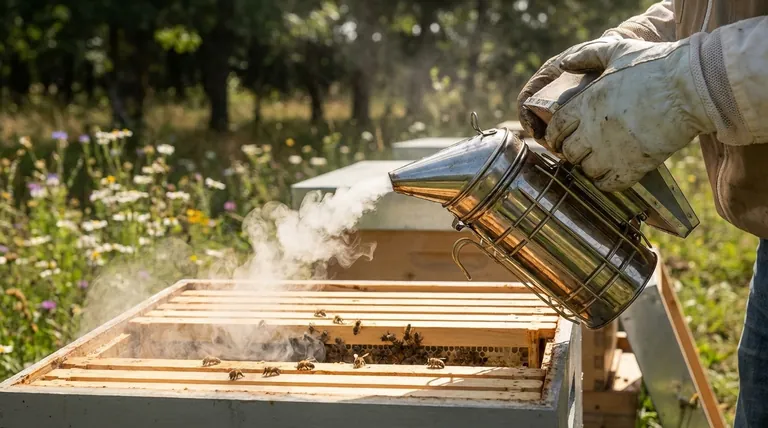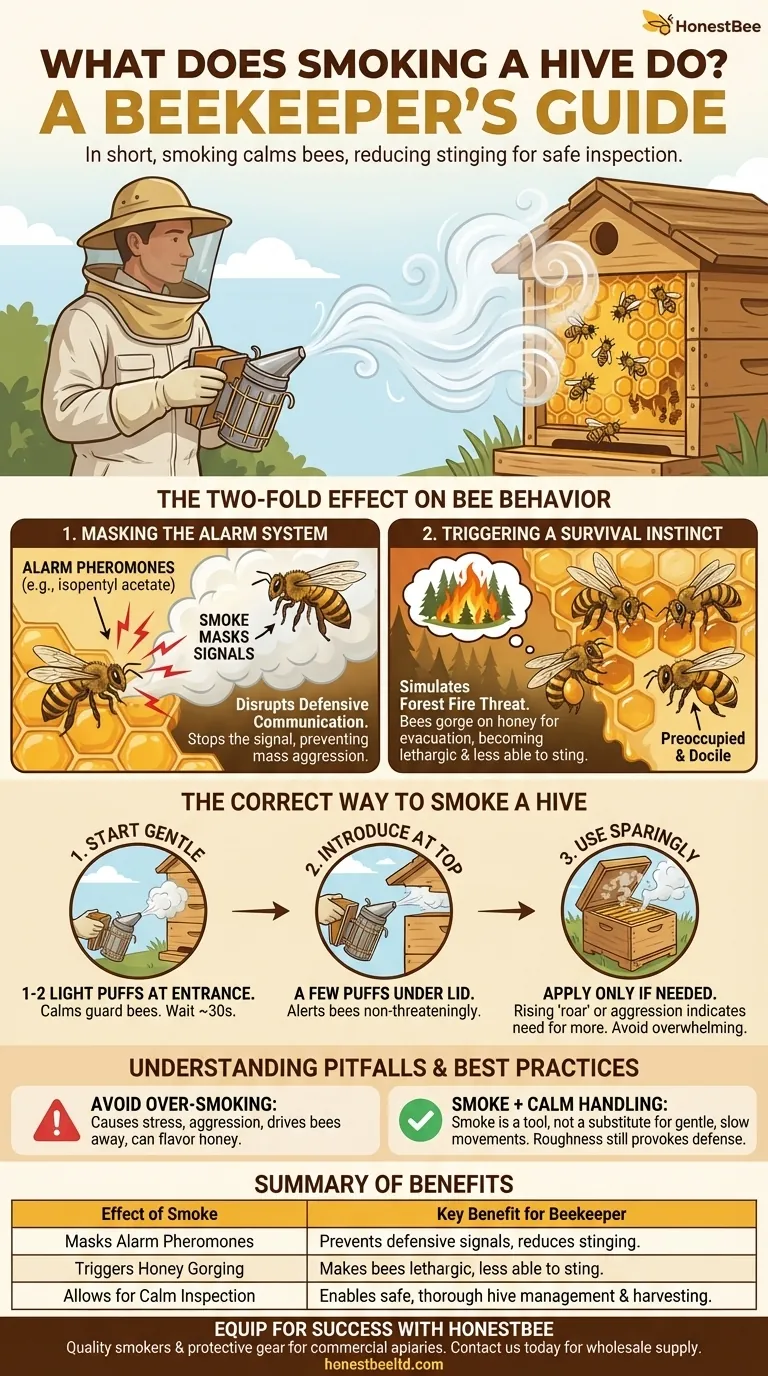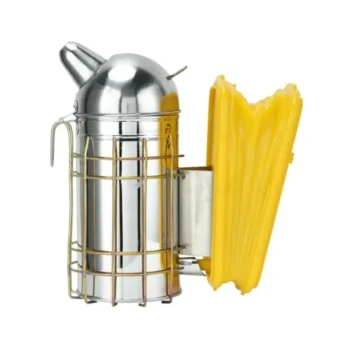In short, smoking a hive calms honey bees and makes them less likely to sting. It works by disrupting their primary defensive communication and triggering a secondary survival instinct. This allows a beekeeper to safely open and inspect the colony without provoking a mass defensive response.
The core principle is interruption. Smoke acts as both a chemical mask and a false alarm, effectively scrambling the bees' ability to communicate danger and shifting their focus from defense to self-preservation.

The Two-Fold Effect of Smoke on Bee Behavior
To use smoke effectively, it is essential to understand the two distinct biological responses it triggers in a honey bee colony. Both work in concert to create a more docile and manageable hive.
Masking the Alarm System
Honey bees coordinate their defense using chemical signals called alarm pheromones. When a guard bee perceives a threat, it releases pheromones like isopentyl acetate and 2-heptanone.
These chemicals act as an alarm bell, instantly signaling to other bees that the hive is under attack and triggering aggressive, stinging behavior. Smoke effectively masks these pheromones, preventing the signal from spreading throughout the colony. It's like cutting the communication line for their defensive platoon.
Triggering a Survival Instinct
Smoke also simulates a natural threat: a forest fire. When bees detect smoke, their ancient survival instincts tell them their home may be destroyed and they might need to flee.
In preparation for a potential evacuation, the bees begin to gorge on honey, loading up on energy reserves. A bee with a full stomach is physically less able to flex its abdomen to sting. This engorged, preoccupied state makes them significantly more lethargic and docile.
The Correct Way to Smoke a Hive
Applying smoke is a technique that requires finesse. The goal is to gently calm the bees, not to overwhelm them.
Start with a Gentle Introduction
Before you even open the hive, apply one or two light puffs of cool, white smoke near the main entrance. This calms the guard bees on duty.
After waiting about 30 seconds, crack the lid open slightly and direct a few more puffs across the top of the frames. This alerts the bees inside to your presence in a non-threatening way.
Use Smoke Sparingly
Once the hive is open, set your smoker aside but keep it within reach. You have already disrupted their initial communication and triggered the honey-gorging response.
Only apply additional smoke if the bees begin to show signs of agitation or aggression. This is often indicated by a rising "roar" from the hive or bees flying directly at your face veil.
Understanding the Pitfalls
While a critical tool, smoke can be misused. Understanding its limitations is key to responsible beekeeping.
The Danger of Over-Smoking
Using too much smoke is counterproductive and harmful. Excessive smoke will drive bees away from the frames, making inspection difficult, and can even cause them to become stressed and aggressive.
It can also impart an undesirable smoky flavor to honey if used heavily during a honey harvest. The principle is to use the minimum amount of smoke necessary to keep the colony calm.
Smoke is Not a Substitute for Calm Handling
Smoke is a tool to manage a colony’s natural defensiveness, not an excuse for rough or hasty work. All movements should still be slow and deliberate.
Dropping tools, bumping the hive, or crushing bees will still provoke a defensive reaction, which even smoke may not be able to fully suppress. Gentleness is always the primary rule.
Making the Right Choice for Your Inspection
Apply smoke with a clear purpose based on the task at hand.
- If your primary focus is a quick, routine inspection: A few puffs at the entrance and under the lid are likely all you will need to complete your work.
- If your primary focus is a long or invasive procedure (like a harvest or requeening): Be prepared to apply small, targeted puffs every few minutes to maintain a calm atmosphere as you work deeper in the hive.
- If your primary focus is managing a known "hot" (aggressive) colony: Use smoke deliberately to interrupt their defensive chain of command from the start, but remain mindful not to overwhelm them.
Ultimately, using smoke is about working with the bees' nature, not against it.
Summary Table:
| Effect of Smoke | Key Benefit for the Beekeeper |
|---|---|
| Masks Alarm Pheromones | Prevents defensive signals from spreading, reducing stinging. |
| Triggers Honey Gorging | Makes bees lethargic and less able to sting. |
| Allows for Calm Inspection | Enables safe, thorough hive management and honey harvesting. |
Ready to inspect your hives with confidence?
Proper technique starts with the right equipment. HONESTBEE supplies commercial apiaries and beekeeping equipment distributors with high-quality, reliable smokers and protective gear through our wholesale-focused operations.
Let us equip you for success. Contact our team today to discuss your beekeeping supply needs and ensure your operations run smoothly and safely.
Visual Guide

Related Products
- European Stainless Steel Bee Smoker for Honey Bee Hive
- Stainless Steel Honey Bee Smoker Hive and Honeycomb Smoker for Beekeeping
- Electric Bee Smoker European Style Bee Hive Smoker for Beekeeping
- Heavy Duty Manual Bee Smoker Blower for Beekeeping
- Stainless Steel Electric Beehive Smoker for Beekeeping and Bee Keeper Use
People Also Ask
- What are the features of a recommended bee smoker? A Guide to Safety, Durability & Performance
- What are the benefits of cleaning a bee smoker? Ensure Hive Safety and Bee Health
- What are the key benefits of using a bee smoker? Master Hive Inspections Safely and Efficiently
- What are the benefits of smoking bees? Achieve Safer, Calmer Hive Inspections
- What are the steps to operate a bee smoker? Master the Art of Gentle Beehive Management



















